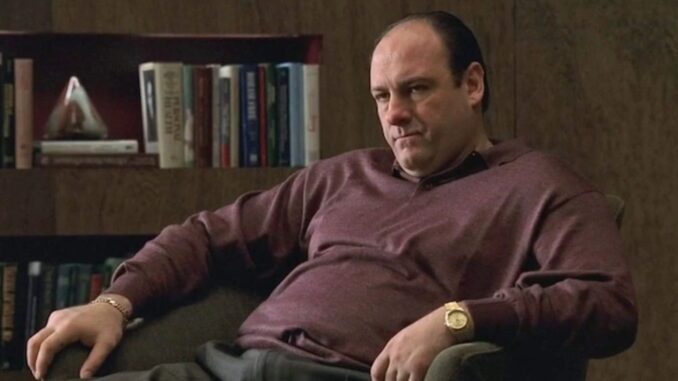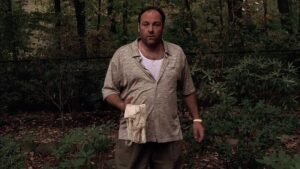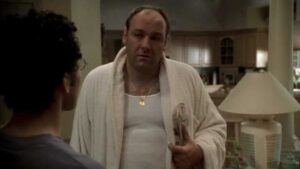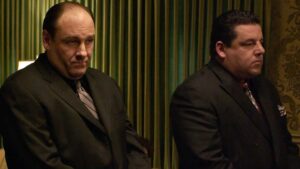
The Sopranos premiered 25 years ago and since then, it has remained the touchstone from which other crime shows are measured. From great characters to gripping plots, the HBO drama has a lot to offer. The quality is hardly surprising considering that most of the storylines were penned by some of the industry’s best writers, including the talented trio of Matthew Weiner, Terrence Winter, and series creator David Chase. In 2013, the Writers Guild of America named it the best-written show of all time.
As stainless as The Sopranos might seem, it has a few questionable, pointless, or disturbing aspects, many of which were excusable when the show first aired, but are more glaring now. Given how progressive society has become and how much the quality of television has improved, it’s now time to put the series on trial for some of its crimes. While the charges might not ruin the crime drama’s reputation, the entire story might have been cooler if these issues didn’t exist.
10 Bizarre LGBTQ Storylines
Many of the greatest gangster TV shows have no major LGBTQ storylines so The Sopranos stands out by at least going that route. Still, the gay characters are handled too harshly. One of the DiMeo crime family’s capos, Vito Spatafore, remains in the closet for a long time. He even gets married and has two children. When a Lupertazzi crime family member spots him at a gay bar, Vito chooses to go into hiding.
To Vito, the Mob Life Is Better than a Perfect Relationship
The general level of homophobia is frightening and, to make matters worse, the victim is still painted as a villain. Vito is the kind of character that should be pitied and rooted for. Instead, the show makes him detestable, and it’s all because of his questionable choices.
During his time in hiding, he begins a relationship with Jim, a short-order cook. Jim adores Vito, but the mobster later abandons him to return to New Jersey to resume his mob life. Along the way, he kills a stranger after a minor disagreement. After returning to his home city, he gets brutally murdered.
9 Tony’s Plot Armor

The Sopranos subverts many gangster genre tropes and offers a realistic portrayal of modern post-Gotti-era mob life. Regrettably, Tony, like many other screen protagonists and antiheroes, benefits from plenty of plot armor. There’s only ever one serious attempt on his life (which he survives), and the feds seem less interested in capturing him, yet they ferociously go after everyone else.
The DiMeo crime family boss glides through the entire show without ever appearing before a senate committee or setting foot in jail.
Sections of fans might argue that Tony doesn’t benefit from plot armor or luck. He is simply too smart. But is he? If Phil Leotardo can tear Tony’s organization apart in such a short period, the FBI shouldn’t have to struggle to pin the man down. Even worse, no member of the DiMeo crime family makes a serious effort to overthrow Tony. Toppling the leader has been a common practice in the mob since the early ‘20s, but Tony never has to worry about such problems. Richie Aprille considers it but never really pursues the goal.
8 The Blatant Racism

Generally, The Sopranos offers an enthralling study on the poisonous effects of greed, placing dark comic twists on the familiar get-rich-fast premise. However, it occasionally strays by turning some of its characters into racist pricks. Take the scene where Tony’s daughter Meadow introduces her black boyfriend, Noah, to him, and he goes completely nuts.
When Meadow briefly goes to her room, Tony shamelessly orders Noah to draft a breakup speech.
“When my little girl comes down the stairs, you’re going to say how nice it was to meet me, then you’re going to go drop her off at school, and then you’re going to say goodbye.”
Tony Goes Full KKK
David Chase draws splendid performances from Patrick Tully and James Gandolfini in this scene. Tully is especially more impressive as he transforms from an anxious third party into a steely-eyed teen ready to stand up against racism.
“F*** you,” he says to his girlfriend’s dad, but his brief retaliation is noble compared to what Tony throws at him. The mob boss refers to him as a charcoal briquette, a mulligan, and a ditsoon. This kind of wording is odd, coming from one of the greatest TV characters of all time, yet there was no uproar 25 years ago. The show also has another questionable plot where Tony’s men try to break up a Native American protest.
7 Many Unresolved Storylines

Where did the rapper Massive Genius (Bokeem Woodbine) go? From the outside, the show might seem like it has no hanging threads, but it actually has plenty. One of the major ones stems from one of the most memorable episodes, “Pine Barrens.” In it, Christopher and Paulie believe they’ve killed the Russian mobster, Valery, but when they go to bury his body in the New Jersey Pine Barrens, he takes off. The cat-and-mouse game ends without a payoff and Valery is never seen again.
The Guessing Game Continues
To be fair, most storylines in the crime drama have an ideal denouement, but this doesn’t mean the slips should be excused. The best-written TV show of all time ought to have no unattached cables. Fans would want to know what happened to Furio after he fell for Tony’s wife, Carmella, and fled to Italy. Was he tracked down and killed or did he choose to break omertà before going into witness protection? Only David Chase knows.
6 Gender-Based Violence

Many key characters in the show get physical with women. Tony does so during his pre-break-up argument with Carmela, pinning her to the wall. Christopher also puts his hands on Adriana and Ralph murders his girlfriend, Tracee in the open. Tony’s sister, Janice, also gets attacked by her lover, Richie Aprille, but she retaliates in a major way by shooting him.
There’s Rarely Any Punishment
What’s sad about these incidents is that there were rarely any consequences. Throughout the show, we see characters getting comeuppance for other misdemeanors. For example, Ralph pays for constantly being disrespectful to Tony and other mobsters, but he never pays for killing Tracee. Christopher too, never pays for mistreating Adriana. Instead, it’s she who is punished for talking to the authorities, yet she isn’t the one who approached them in the first place.
5 Little to No Female Empowerment
The mafia has always been male-dominated, but as a show that mostly aired in the 21st century, The Sopranos could have empowered its women a lot more. Out of all the female characters, only Dr. Jennifer Melfi remains on a stable professional path. Others like her who get decent jobs, like Agent Deborah Ciccerone, only appear briefly. The rest are relegated to mob wife roles.
A Missed Opportunity
Female crime bosses can be interesting. Shows like Griselda, All the Queen’s Men, and Queen of the South prove it. The HBO drama would, therefore, not have been weaker for featuring powerful women. A great opportunity is missed with Annalisa Zucca, a Camorra boss that Tony meets while visiting Naples. She could have played a crucial role in the proceedings but after four scenes, she was never seen again.
4 Where Is Bobby in Season 1?

As the kindest mobster on the show, Bobby Baccala finds more pleasure in being a personal assistant to Junior than in committing crimes. He is introduced in Season 2 as one of the key members of Junior’s crew. Eventually, he becomes one of the DiMeo crime family’s high-ranking members. But where was he in Season 1? Given how dependent Junior is on Bobby, he ought to be around from the beginning. No explanation is offered as to where he was.
A Simple Behind-the-Scenes Answer
Regarding Bobby’s absence, the answer is simple: Steve Schirripa hadn’t been cast yet. The producers also didn’t know that such a character would be needed. Even so, a proper plot explanation should have been provided. After all, the show perfectly explains the absence of many other characters, notably Richie Aprille, and Ralph. The reason for Big Pussy’s time away from the screen is also explained in detail.
3 The Minor Continuity Errors
The critically acclaimed HBO drama sure seems meticulously written and perfectly edited. With its rigorous use of varied camera angles, Zen-like shots, and multilayered narration style, it has become a prototype of sorts for other showrunners. However, upon close perusal, a few continuity errors can be spotted, proving that David Chase and his team were human after all.
No One Noticed That?
There are several examples of continuity issues on the show, though most of them are tied to the visuals rather than the story.
When Gigi is chatting with Tony at the Bada Bing, a stack of cash next to them keeps appearing and disappearing. When Tony is chatting with Agent Harris at Satriale’s Pork Store, his Escalade (seen through the window) also keeps appearing and disappearing. The same can be said of the magazine Valentina is reading when Tony visits her at the hospital, and the blood stain on Tony’s vest after his fight with Bobby.
2 Mob Traditions Aren’t Adhered To
Cosa Nostra members live by a code and a certain set of traditions. So, why do so many characters ignore them? Like Dominic Toretto, the characters keep emphasizing that there is nothing more important than family, yet Paulie, one of the most prominent mobsters, is unmarried and without kids, despite being past his 50s. He doesn’t have a goomah either.
In Season 6, Bobby is revealed to have never killed anyone, leaving viewers wondering how he became a Made Guy in the first place. In addition to that, so many mobsters become informants. Not to forget Furio falling for his boss’ wife.
Rebellion Without Consequences
So many mobsters are rebellious and they never face any consequences. It could be presumed that this is just the nature of the ‘90s and 2000s crop of Cosa Nostra gangsters. Newer generations generally have a habit of breaking old rules.
It would make sense for Silvio to pressure Paulie to marry, letting him know that his bachelor lifestyle is part of why their enemies consider this a “glorified crew.” It would also make more sense for Bobby not to be a Made Guy since he hadn’t “made his bones.”
1 Plenty of Body-Shaming
Weight is a major issue in the show, and like racism, it isn’t handled well. “Oh, look at that! It’s like an ad for a weight loss center. Before, and way before!” Paulie says after spotting Bobby and Vito standing beside each other at the Bada Bing. Tony also tells Bobby to stop leaning on his car because he might accidentally flip it over. The most insensitive remark comes from Ralph, who jokes that Johnny Sack’s wife, Ginny Sacrimoni had a 90 lb mole removed from her rectum.
There Are Better Ways to Address the Weight Issue
The Sopranos could have benefited from a little more sensitivity. After all, there are better ways to address the weight issue and the show even adopts one of them. For example, in the Season 6 premiere “Members Only,” Vito is revealed to have lost 160 pounds and even appeared in a weight-loss commercial. Such an approach gives a better message than having Ginny hide packs of candy to consume them when her husband isn’t watching.
